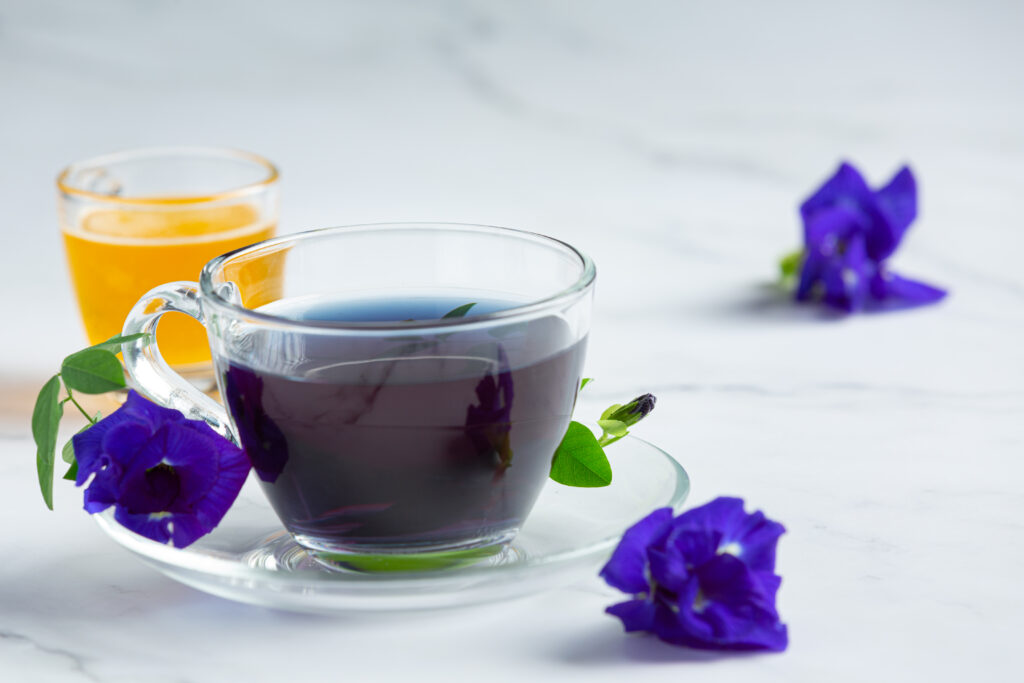In the world of wellness and herbal teas, a new star has risen: Blue Tea, also known as Butterfly Pea Flower Tea. This stunningly blue beverage is gaining popularity not just because of its vibrant color but also for its potential health benefits.
Blue tea is made from the dried flowers of the Clitoria ternatea plant, commonly known as butterfly pea.
Native to Southeast Asia, this herbal tea has been used in traditional medicine for centuries, and today, it’s being hailed as a natural health booster worldwide.
In this blog, we’ll explore blue tea benefits, why it’s becoming so popular, and how you can incorporate it into your daily routine for a healthy lifestyle.
What is Blue Tea?
Blue tea is made by steeping dried butterfly pea flowers in hot water. The result is a brilliant blue liquid that is naturally caffeine-free and loaded with antioxidants. The tea has a subtle, earthy flavor, similar to green tea but milder.
Blue tea is also known as Aparajita flower tea India and other South Asian countries where Sanskrit-derived names are commonly used.
One of its coolest features? When you add a squeeze of lemon or lime, the tea transforms into a vibrant purple hue. This color-changing property makes it not only a healthy drink but also a fun, Instagram-worthy experience.
In Thailand and Malaysia, blue tea has been used for centuries in both cuisine and traditional medicine. It’s also known for its unique anti-aging and beauty-enhancing properties, which we’ll dive into shortly.
Health Benefits
Here are the blue tea benefits for health:
1. Rich in Antioxidants
One of the major reasons for blue tea’s growing popularity is its antioxidant content.
Antioxidants are compounds that help combat free radicals in the body, which can lead to oxidative stress, a major factor in aging and chronic diseases like cancer and heart disease.
Blue tea, made from butterfly pea flowers, is naturally rich in anthocyanins, a type of flavonoid that also gives the tea its vibrant blue color.
These flowers are packed with powerful plant compounds such as phenolics, flavonoids, quercetin, kaempferol glycosides, myricetin glycosides, tannins, terpenoids, and steroids—many of which are known for their antioxidant activity.
Research has shown that beverages made from dried butterfly pea flowers, like blue tea, offer strong antioxidant properties. They help neutralize harmful molecules and protect cells from oxidative damage.
By drinking blue tea regularly, you may help reduce oxidative stress in the body, which in turn could lower your risk of chronic diseases and support better overall health.
2. May Improve Brain Function and Memory
Blue tea has long been used in traditional medicine as a brain-boosting herb.
Butterfly pea contains natural compounds with nootropic properties—meaning they may help enhance brain function, improve memory, and reduce mental fatigue.
In one animal study, researchers tested ethanolic extracts from the roots and aerial parts (leaves, stems, flowers, fruits, and buds) of the butterfly pea plant on memory loss caused by electric shocks.
The results were promising: a 300 mg/kg dose improved memory retention and increased levels of acetylcholine, a key neurotransmitter involved in learning and memory. Interestingly, the 300 mg dose was more effective than the higher 500 mg dose. The root extract showed even stronger results, with similar benefits at both tested doses.
While these findings are encouraging, it’s important to note that human studies are still limited. More research is needed to fully understand how blue tea and butterfly pea affect the human brain.
3. May Help Manage Blood Sugar Levels
Blue tea has been studied for its potential to lower blood sugar levels and support diabetic health.
Research shows that blocking enzymes like pancreatic alpha-amylase and intestinal alpha-glucosidase slows down the digestion and absorption of carbohydrates, which helps control high blood sugar levels after meals.
Butterfly pea flower contains polyphenols and anthocyanins, which have been shown to inhibit above enzymes (α-amylase and α-glucosidase).
Despite using similar amounts of butterfly pea flower extract, two studies yielded different results regarding its impact on blood sugar levels.
In a study of 15 healthy men, consuming beverages with 1 or 2 grams of butterfly pea flower extract combined with sucrose significantly reduced postprandial blood glucose and insulin levels within 30 minutes, whereas the extract alone had no effect on fasting glucose or insulin.
Conversely, in another study involving 16 participants (9 overweight and 7 obese), no significant differences in blood sugar levels were observed after consuming a high-fat meal with 1 or 2 grams of butterfly pea flower extract, compared to the high-fat meal alone.
These studies highlight the challenges of using butterfly pea flower extract to manage blood sugar levels through diet.
More comprehensive studies are necessary to clarify the conditions under which butterfly pea flower extract may be effective.
4. May Support Heart Health
Blue tea, made from butterfly pea flowers, offers several heart health benefits.
Blue tea has been shown to improve circulation by dilating blood vessels, potentially lowering blood pressure.
In an animal study, rats were given L-NAME to induce high blood pressure and treated with butterfly pea flower extract (rich in flavonoids) or lisinopril for 5 weeks. Butterfly pea flower extract reduced blood pressure, improved vasorelaxation, and prevented heart damage.
Butterfly pea flower has also been shown to aid in cholesterol management, particularly by reducing unusual cholesterol levels.
The earlier-mentioned study of 16 participants (9 overweight and 7 obese) found that after eating a high-fat meal, adding 2 grams of butterfly pea flower extract significantly lowered post-meal triglyceride and free fatty acid levels over time, especially at 360 minutes, compared to the meal without the extract or with 1 gram of extract.
This indicates that the extract may help manage high blood lipid levels after eating, which is linked to heart disease.
Blue tea may aid in weight management due to its unique properties.
Blue tea contains antioxidants that may boost metabolism and improve fat oxidation. The tea is also low in calories, making it a healthy alternative to sugary beverages.
A study was conducted among members of the Indonesian National Army with a BMI over 25 to examine how the frequency of drinking blue tea affects weight (BMI) and cholesterol levels.
Results showed that drinking the tea twice, three times, or five times a week significantly reduced BMI and cholesterol, with the most considerable effects noted with five cups weekly. The differences among the results were statistically significant.
What’s more!, just add a cup of blue tea to your weightloss diet, and combine it with regular exercise for effective results in your weight management goals.
6. Antibacterial Properties
Another study found that crude extracts of butterfly pea flower showed antibacterial activity against E. coli, K. pneumoniae, and P. aeruginosa isolated from patients.
This antibacterial effect of butterfly pea flower is attributed to the presence of anthocyanins in the flower, which are known for their bioactive properties.
However, further research is needed to find the mechanism of this activity and its potential against the risk of bacterial infection.
7. Caffeine-free Alternative
One of the most prominent benefits of blue tea is it is caffeine-free.
As blue tea is derived from the butterfly pea flower, which is a naturally caffeine-free, makes it an excellent choice for those seeking to reduce their caffeine intake.
This vibrant blue tea offers a flavorful experience without the jitters associated with caffeinated drinks.
In addition to its calming properties, blue tea is rich in antioxidants, providing a refreshing option that can be enjoyed any time of day, especially in the evening.
How to Prepare Blue Tea
Making blue tea is incredibly simple. Here’s a step-by-step guide:
Ingredients:
- 1 teaspoon of dried butterfly pea flowers (about 4–5 flowers)
- 1 cup of hot water
- Optional: lemon juice, honey, or mint for flavor
Instructions:
- Boil 1 cup of water.
- Add the dried butterfly pea flowers to a teapot or cup.
- Pour the hot water over the flowers and let them steep for 5–10 minutes.
- The water will turn a vibrant blue color. You can add a squeeze of lemon or lime to turn the tea purple.
- Sweeten with honey or add mint if desired.
- Enjoy your blue tea warm or over ice!
Potential Side Effects
Blue tea is generally safe for most people when consumed in moderation.
However, excessive consumption may cause mild side effects such as nausea or digestive discomfort.
People on blood-thinning medications or with low blood pressure should consult a doctor before drinking blue tea.
In Closing
With its stunning color and wide range of health benefits, blue tea has become a popular choice for wellness enthusiasts worldwide.
Whether you’re looking to improve heart health, boost brain function, or simply relax and de-stress, blue tea has impressive benefits to offer. Plus, its unique color-changing properties make it a fun addition to your daily tea ritual.
However, most benefits are based on butterfly pea flower extract, not its tea, where only a few studies exist. More research on blue tea is needed to uncover its full potential and determine optimal dosages for effective results.
As with any herbal remedy, it’s important to enjoy blue tea in moderation and consult your doctor if you have any existing medical conditions. But overall, blue tea is a safe, caffeine-free, and antioxidant-rich drink that can add a refreshing and healthy touch to your day.
So why not brew yourself a cup of this magical tea and see what it can do for you?
You may also explore
10 Health Benefits of Green Tea with Lemon
9 Amazing Benefits of Black Raisins
References:
- Image by jcomp on Freepik
- Sowmya R, Supriya V, Rajkumar M (2023) Clitoria ternatea (Butterfly Pea) – A Plant with Antioxidant and Antidiabetic Properties. Indian Journal of Science and Technology 16(31): 2431-2440. https://doi.org/10.17485/IJST/v16i31.1166. Used under CC BY 4.0.
- Pruteanu LL, Bailey DS, Grădinaru AC, Jäntschi L. The Biochemistry and Effectiveness of Antioxidants in Food, Fruits, and Marine Algae. Antioxidants (Basel). 2023 Apr 2;12(4):860. doi: 10.3390/antiox12040860. PMID: 37107235; PMCID: PMC10135154. Used under CC BY 4.0.
- Mehla J, Gupta P, Pahuja M, Diwan D, Diksha D. Indian Medicinal Herbs and Formulations for Alzheimer’s Disease, from Traditional Knowledge to Scientific Assessment. Brain Sci. 2020 Dec 10;10(12):964. doi: 10.3390/brainsci10120964. PMID: 33321899; PMCID: PMC7764187. Used under CC BY 4.0.
- Jeyaraj EJ, Lim YY, Choo WS. Antioxidant, cytotoxic, and antibacterial activities of Clitoria ternatea flower extracts and anthocyanin-rich fraction. Sci Rep. 2022 Sep 1;12(1):14890. doi: 10.1038/s41598-022-19146-z. PMID: 36050436; PMCID: PMC9436976. Used under CC BY 4.0.
- Eddy Purnomo
Departemen Pendidikan Olahraga, Fakultas Ilmu Keolahragaan dan Kesehatan, Universitas Negeri Yogyakarta, JI. Colombo No. 1, Karangmalang, Depok, Sleman, Daerah Istimewa Yogyakarta, Indonesia. Used under CC BY-SA 4.0. - Pathaw N, Devi KS, Sapam R, Sanasam J, Monteshori S, Phurailatpam S, Devi HC, Chanu WT, Wangkhem B, Mangang NL. A comparative review on the anti-nutritional factors of herbal tea concoctions and their reduction strategies. Front Nutr. 2022 Oct 5;9:988964. doi: 10.3389/fnut.2022.988964. PMID: 36276812; PMCID: PMC9581206. Used under CC BY 4.0.
- Chusak C, Thilavech T, Henry CJ, Adisakwattana S. Acute effect of Clitoria ternatea flower beverage on glycemic response and antioxidant capacity in healthy subjects: a randomized crossover trial. BMC Complement Altern Med. 2018 Jan 8;18(1):6. doi: 10.1186/s12906-017-2075-7. PMID: 29310631; PMCID: PMC5759795. Used under CC BY 4.0.
- Thilavech T, Adisakwattana S, Channuwong P, Radarit K, Jantarapat K, Ngewlai K, Sonprasan N, Chusak C. Clitoria ternatea Flower Extract Attenuates Postpandial Lipemia and Increases Plasma Antioxidant Status Responses to a High-Fat Meal Challenge in Overweight and Obese Participants. Biology (Basel). 2021 Sep 28;10(10):975. doi: 10.3390/biology10100975. PMID: 34681074; PMCID: PMC8533577. Used under CC BY 4.0.
- Maneesai P, Iampanichakul M, Chaihongsa N, Poasakate A, Potue P, Rattanakanokchai S, Bunbupha S, Chiangsaen P, Pakdeechote P. Butterfly Pea Flower (Clitoria ternatea Linn.) Extract Ameliorates Cardiovascular Dysfunction and Oxidative Stress in Nitric Oxide-Deficient Hypertensive Rats. Antioxidants (Basel). 2021 Mar 27;10(4):523. doi: 10.3390/antiox10040523. PMID: 33801631; PMCID: PMC8065438. Used under CC BY 4.0.



